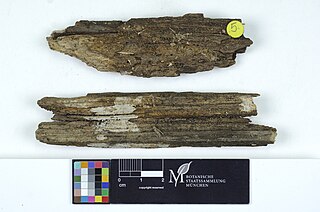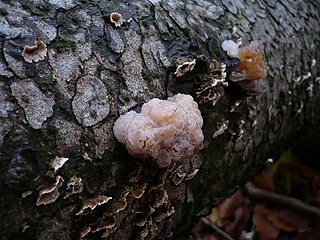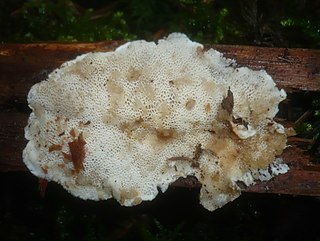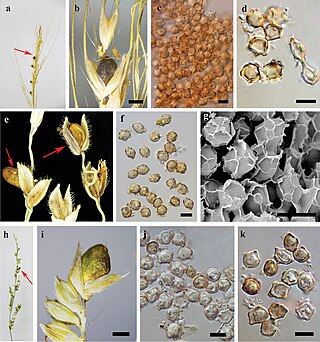The Cuniculitremaceae are a family of fungi in the order Tremellales. There are three genera in the family. Sterigmatosporidium polymorphum parasitizes other fungi growing in insect galleries in wood. It does not produce basidiocarps, but has septate basidia similar to those found in the genus Tremella. Most species are known only from their yeast states.
The Cystofilobasidiaceae are a family of fungi in the order Cystofilobasidiales. Phylogenetic analyses shows that this family is clearly distinct from other yeast-like families of the Tremellomycetes. The family currently contains the single genus Cystofilobasidium. Additional genera previously referred to the Cystofilobasidiaceae are now placed in the Mrakiaceae.
Moniliella is a genus of fungi in the subdivision Ustilaginomycotina. It is in the monotypic family MoniliellaceaeQ.M. Wang, F.Y. Bai & Boekhout, which is in the monotypic order MoniliellalesQ.M. Wang, F.Y. Bai & Boekhout which is in the monotypic class MoniliellomycetesQ.M. Wang, F.Y. Bai & Boekhout.
Bulleribasidium is a genus of fungi in the family Bulleribasidiaceae. The genus currently contains some eleven species. The type species is a parasite of other fungi, its teleomorph having septate basidia and haustorial cells on its hyphae that connect to the host hyphae. Most species are, however, only known from their yeast states.
Dioszegia is a genus of fungi in the family Bulleribasidiaceae. The genus, comprising anamorphic forms, has a widespread distribution, and contains around 16 species.
Kwoniella is a genus of fungi in the family Cryptococcaceae. The genus originally contained the single species Kwoniella mangrovensis, found in the Florida Everglades and The Bahamas. Molecular research, based on cladistic analysis of DNA sequences, has however, now extended the genus to eleven species, most known only from their yeast states.
Trimorphomyces is a genus of fungi in the family Trimorphomycetaceae. The genus currently contains two species. The type species is a parasite of another fungus in the genus Arthrinium, forming small gelatinous basidiocarps containing distinctive twinned conidia.

Colacogloea is a genus of fungi belonging to the class Microbotryomycetes. Most species in the genus are known only from their yeast states. Where known, basidiocarps have auricularioid basidia and occur as parasites on or in the fruit bodies of other fungi.

Phaeotremella is a genus of fungi in the family Phaeotremellaceae. All Phaeotremella species are parasites of other fungi and produce anamorphic yeast states. Basidiocarps, when produced, are gelatinous and are colloquially classed among the "jelly fungi". Fifteen or so species of Phaeotremella are currently recognized worldwide. Tremella sanguinea, shown to be a Phaeotremella species by DNA sequencing, is cultivated in China as an ingredient in traditional Chinese medicine.
The Mrakiaceae are a family of fungi in the order Cystofilobasidiales. Phylogenetic analyses shows that this family is clearly distinct from other yeast-like families of the Tremellomycetes. The family had six genera in 2015.
Cystofilobasidium is a genus of fungi in the family Cystofilobasidiaceae. Species occur as yeasts, but produce filamentous sexual states that form dikaryote teliospores, from which the unicellular basidia are formed. The hyphae usually have dolipore septa without a parenthesome, and their cell walls contain xylose. The genus currently contains nine species worldwide.

Naematelia is a genus of fungi in the family Naemateliaceae. All Naematelia species are parasites of other fungi and produce anamorphic yeast states. When produced, Basidiocarps ,, are gelatinous and are colloquially classed among the "jelly fungi."Four species of Naematelia are currently recognized worldwide. One species, Naematelia aurantialba, is commercially cultivated for food.
Pseudotremella is a genus of fungi in the family Bulleraceae. All Pseudotremella species are parasites of other fungi and produce anamorphic yeast states. Basidiocarps, when produced, are gelatinous and are colloquially classed among the "jelly fungi". Four species of Pseudotremella are currently recognized worldwide. Two of these species are, as yet, only known from their yeast states.
Naganishia is a genus of fungi in the family Filobasidiaceae. Species are currently only known from their yeast states, most of which were formerly referred to the genus Cryptococcus. Some 15 species have been described worldwide. Naganishia albida is an occasional human pathogen.
The Bulleraceae are a family of fungi in the order Tremellales. The family currently contains five genera. Some species produce gelatinous basidiocarps and were formerly placed in the genus Tremella. Most, however, are only known from their yeast states.
Solicoccozyma is a genus of fungi in the family Piskurozymaceae. Species have only been isolated in their yeast states, several of which were formerly referred to the genus Cryptococcus, but can produce filamentous states with basidia in culture. Nine species have been described worldwide.

The Carcinomycetaceae are a family of fungi in the order Tremellales. The family currently contains a single genus. Some species produce filamentous sexual states with basidia and are parasites of other fungi. Some, however, are only known from their yeast states.

Moesziomyces is a fungal genus in the family Ustilaginaceae.
Cutaneotrichosporon is a genus of fungus in the family Trichosporonaceae. Species within the genus include:
Rhodosporidiobolus fluvialis is a species of fungus in the family Sporidiobolaceae. It is a human fungal pathogen that exhibits resistance to antifungal compounds like fluconazole and caspofungin.




